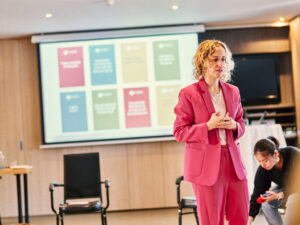Organizations do recognize that habits (culture) and habitat (structure or design) are both critical components of change, innovation, and growth. Want to promote collaboration and drive innovation? Change the culture. Want to recruit top young talent? Change the culture. Want to rebrand? Change the culture. On the flip-side, there’s also a growing preoccupation with design. But there’s a problem. Too few organizations realize that habitat and habits go hand in hand. That’s right. Habitat influences habits and vice versa.
Old Habits Kill New Habitat
Today, everyone is talking about flat organizations, networked organizations and virtual collaboration. Such talk reflects a broader shift to “organizational design” and “design management.” Indeed, Deloitte’s 2016 Global Human Capital Trends report found that organizational design is the year’s top priority, with 92% of surveyed executives citing it as their number one concern. With today’s growing emphasis on organizational design, organizations are changing—or at least attempting to change.
Across industries, companies are lifting and shifting reporting lines, eliminating leadership levels, building new open space offices, and implementing new processes of managing performance. And why not? When organizations redesign along these lines, there is hope that the redesign will kick-start other major changes that impact everyone from frontline staff to senior leaders. The radical restructuring to which we are now bearing witness holds the potential to empower managers to make decisions, encourage people to mentor and teach across teams, promote cross-training at all levels and even change how senior leaders work. The problem is that this potential for change is rarely realized.
The truth of the matter is that one can take the principles of organizational design and design management seriously into account and put these principles into action, but it is wrong to assume that design necessarily impacts culture. If you create an open office and encourage workers to ditch their suits for casual clothes, don’t assume you can create the energy of a start-up overnight, and don’t assume that employees will suddenly be collaborating with each other across departments and levels. Putting a bunch of suits in jeans and hoodies and placing them in an open office—even encouraging them to skateboard or use scooters to get around the workplace—is simply not enough to change how people think, work, and interact with each other.
Consider the following example. A midsize manufacturing company decides to implement a new performance management system with regular feedback. The goal is to promote transparency and to support heightened employee mentorship. The problem is that the culture of the company has always been about avoiding and covering up mistakes. The organization has also never been a place where one can easily express their opinion. In short, it has always been a place where gossip is valued more than open and direct feedback. So what happens? The organization doesn’t change. In fact, the new performance management system is embraced by some employees and managers as a tool to attack each other. In short, the new system—adopted to promote transparency and mentorship—becomes a way to reinforce the organization’s already toxic environment.
The above example is by no means unique. Even after organizations restructure, old allegiances often prevail. In other words, the actual “sociogram” of an organization is often very different from the official “organogram.” Said another way, old habits—for example, toxic and competitive workplace behaviors—have the power to kill new habitat, even new habitat designed work against the proliferation of these very habits.
Old Habitat Kills New Habits
Just like organizational design and design management, in 2016, it seems like companies around the globe are embracing “culture” as a catchphrase. How popular is culture? In a 2015 Harvard Business Review article on the subject, awarding-winning authors and business analysts Lindsay McGregor and Neel Doshi observed,
“In a recent strategy meeting we attended with the leaders of a Fortune-500 company, the word ‘culture’ came up 27 times in 90 minutes.”
However, as they further observe,
“Business leaders believe a strong organizational culture is critical to success, yet culture tends to feel like some magic force that few know how to control. So most executives manage it according to their intuition.”
That’s right — culture is not only wildly popular but also widely misunderstood by the managers and business leaders who continue to embrace it as an answer.
All over the globe and across industries, companies are declaring that they are changing their culture to become more customer-centric, entrepreneurial, and innovative. Yet, in most cases, these organizations have little or no true understanding of culture and cultural change. Of course, it is good to have ambitions, but saying you’re open, customer-centric, and innovative simply doesn’t mean you are. You can invest in poster campaigns, town hall meetings, and roadshows designed to promote the “new you,” but this doesn’t mean your organizational culture will change overnight. This is especially true if the environment in which your operating continues to contradict the new values you’re intent on fostering.
Again, it is useful to consider a couple of concrete examples.
Imagine an organization that decides it wants to foster a more entrepreneurial culture—one where employees at all levels feel empowered to take the lead on projects and run with them too. Sounds great, right? The problem is that the whole organization is built around internal power structures. It’s a top-down and top-heavy organization where the power and budgets are in the hands of just a few out-of-touch leaders. In fact, the culture of the organization is one where the very people making decisions have little to no interactions with customers. As a result, the conversation is driven by internal communications alone. New ideas rarely find their way into the organization’s sealed infrastructure. This means that innovative solutions to persistent problems don’t even stand a chance.
Similarly, consider a large organization that over the years has created a heavy, complicated structure with an abundance of committees and never-ending decision-making processes. To be fair, the infrastructure was originally built up with the best of intentions. As a large health care company concerned about compliance, the company’s infrastructure was originally put in place to ensure compliance errors never happen. Unfortunately, the company is now at a crisis point. They’ve established a new long-term strategy but concluded that they simply aren’t responsive enough to carry out the strategy. In short, their organizational complexity has contaminated their culture to the point where employees have little to no ownership or decision power. The result is an organization stuck in park — an organization with little hope of moving forward and executing new strategies to remain competitive.
This raises several questions. First, how can a company ever become innovative if its governance is all about risk avoidance? Second, how can a company evolve if its interactions with third parties (customers) are purely transactional — if it fails to recognize the value of extended enterprise? Finally, how can a company excel when the mental and/or physical distance between its research and development experts and marketing people is insurmountable? Put simply, how can its old habitat (infrastructure) stop killing its new and desired habits (culture)?
Coming into Alignment
As suggested above, if you actually want to change the culture of your organization, you need to bring its habitats and habits into alignment. The real question, of course, is how to get started?
First, engage the whole organization in a dialogue on how to translate the company’s strategy/purpose into a coherent set of guiding principles or a blueprint for both habitat and habits. Ask people who are actually doing the work to reflect on what type of environment they need to succeed. Ask them to imagine the type of organizational structure, physical environment, key processes, and critical tools they require to manifest strategy. Also, ask people on the ground — employees in research, development, and marketing — and leaders to reflect on what habits they think should be developed and abandoned. Ask everyone to do this in relation to themselves and in relation to others across the organization and bear in mind that this exercise works best when it goes up and down the organizational ladder.
Once you’ve identified what habits you want to grow and/or abandon, put the tools in place to ensure this actually happens. Regularly survey your employees, customers, and partners. Don’t ask them questions about engagement or satisfaction. Rather ask them where they see/feel/experience inconsistencies with regard to your organizational strategy, culture, and structure. Then, be transparent — fully transparent — and share this data with the entire organization. This will help both leaders and employees become increasingly aware of their “real self” instead of blindly believing that the organization’s vision statement or mandate actually reflects reality.
Finally, and most importantly, avoid riding someone else’s wave. Don’t assume you have to announce yourself an enclave for the “creative class” just because Richard Florida has declared the “creative class” to be the most powerful force in today’s workforce. Also, don’t assume you have to start wearing jeans and a gray t-shirt just because Mark Zuckerberg has adopted this as a uniform. In short, don’t assume you have to embrace another business professor’s or CEO’s “enlightened” views on business or adopt their prescribed formula for transforming how things should be done. The goal is not to copy other experts’ answers but rather to discover which questions they asked to reach their own success.
What’s the takeaway? There is no one formula for bringing habitat and habits into alignment. Yet, sustained organizational change is contingent Kon aligning habitat and habits. The challenge is to ask the questions that will help discover how to bring habitat and habits permanently into alignment.





